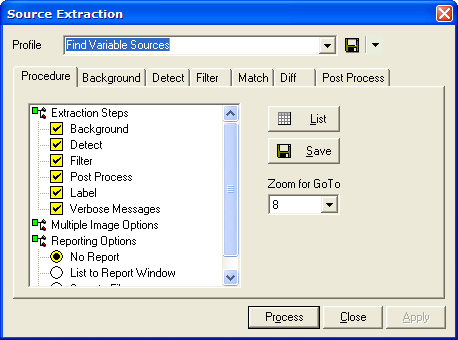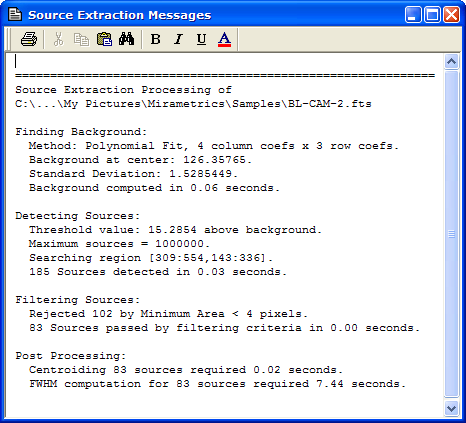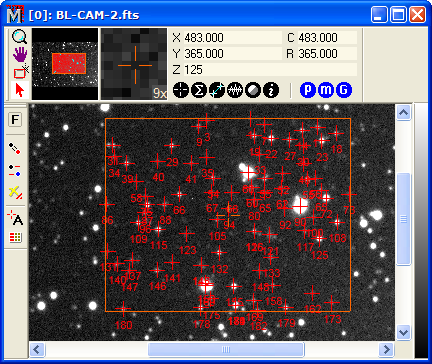Running the Source Extraction Pipeline
MExtract Module
This topic describes the common procedure used for
operating the extraction pipeline. There is also a Tutorial that
describes the process in far greater depth.
Procedure
Extracting sources involves setting up preferences
and then running a procedure to extract source data using those
preferences. This is done using the following sequence of
operations:
-
Open the Source Extraction Toolbar using the
Measure > Extract
Sources command.
-
If you want to extract sources inside a region
of interest (not the entire image), adjust the size and position of
the image cursor so it outlines your region of interest.
-
Click  to open the
Source
Extraction dialog.
to open the
Source
Extraction dialog.
-
Choose an existing profile or set preferences
for a new procedure.
-
Click [Process] to
execute the pipeline.
-
Example
Execute the Measure > Extract Sources command
to open the toolbar. Then click  to open
the Source Extraction dialog shown below.
to open
the Source Extraction dialog shown below.

Now configure the parameters to control your
extraction procedure. You can select an existing Profile or set the preferences
as you need. Then choose one of the following actions:
-
To run the extraction pipeline, click
[Process] at the bottom of the
dialog.
-
To save changes to a new profile, use the
profile
control.
-
To update the currently selected profile, click
[Apply].
During the extraction processing, status messages
can be archived to a text window. If theVerbose box is checked on the Procedure page, then messages are listed in
the Source Extraction Messages window shown below. The
messages listed depends on which Operations and settings are
selected on the pages of the Source
Extraction dialog.

After the source extraction procedure finishes, the
detected and filtered sources are marked as labels on the image as
shown below. Note that can change the source markers and labels
using the Marking
Preferences command from the Source Extraction
Toolbar.

The image window can, of course, be magnified or
otherwise adjusted to get a better view of the sources.
The Procedure lists several Reporting options that
control what happens to the extracted properties. If you want only
to show markers for detected objects, you can choose the No Report
option. Otherwise, you can save the properties to a Report window
or to a text file. If the List to Report Window option is
bulleted, the data will be listed to a window like this:

When a large number of objects is detected in an
image (for example, when there are truly many sources, the image is
large, the detection threshold is low, or by neglecting to use
strong filtering criteria), then labeling the sources
and listing them to the Report window can
take a long time. If you do not need the results displayed
immediately, consider de-selecting the Label step or choosing No
Report in the procedure. If needed at a later time, you can
list the results or save them to a text file using buttons on the
Procedure
page.
Using the Go To Object Command
The table has a Go To
command which allows you to jump from an interesting object in the
report to a close-up view of the object in the image window. To use
this tool, right-click on the row of the target object and then
select Go To Object from the pop-up menu. The image window will
re-center on the target object (provided the object is not too near
the image edge to be centered in the window). The magnification of
the centered view is controlled by the Zoom
for GoTo parameter on the Procedure page.
Related Topics
Extract Sources Command, Extracting Sources from Images, Source Extraction
Definitions, Introduction to
Source Extraction, Report Windows, Measuring Images
![]() to open the
Source
Extraction dialog.
to open the
Source
Extraction dialog.![]() to open
the Source Extraction dialog shown below.
to open
the Source Extraction dialog shown below.


